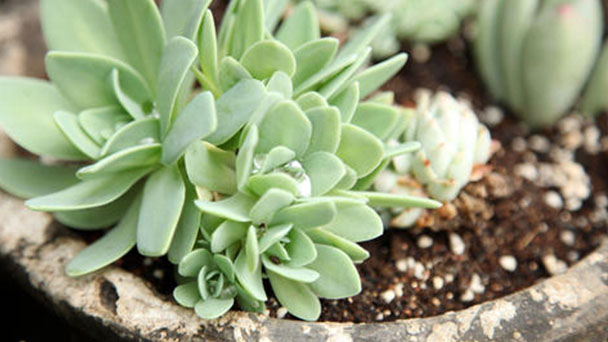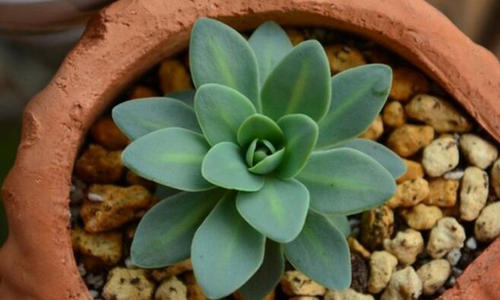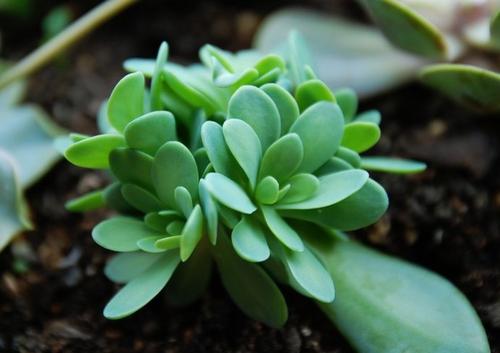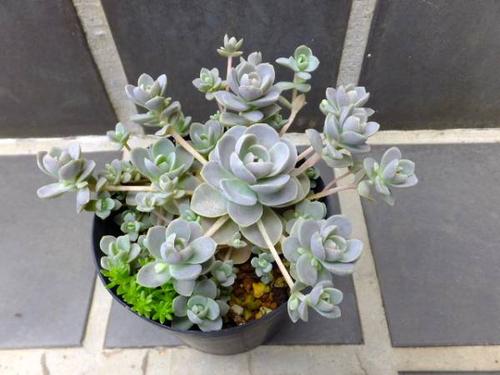Chinese Dunce Cap Succulent (Orostachys iwarenge) Profile
Written by Maggie
Sep 27 2021

Chinese Dunce Cap, also known as Orostachys iwarenge, is a succulent plant of the genus Sedum corvasone, also known as pulp plant, which is distributed in the arid subtropical region of South Africa. Chinese Dunce Cap (Orostachys iwarenge) is the common variety of "phoenix" and has certain ornamental value. Chinese Dunce Cap succulent is very sensitive to high temperature, so it needs to be placed in a cool and well-ventilated place in summer, and it can be watered normally in spring, autumn and winter to increase the sunshine time. Chinese Dunce Cap, like other shasso plants, will die after flowering, so be careful if bud appears.
Chinese Dunce Cap Picture

Chinese Dunce Cap Characteristics
The Chinese Dunce Cap succulent (Orostachys iwarenge) height is 5~7 cm, the rosette diameter is generally 8~10 cm, and the diameter of the old plant can reach 20 cm. Leaf blade is fleshy, with white cream powder; Ovoid, apex has a small tip, the margin is translucent; chinese dunce cap (Orostachys iwarenge) is usually grayish green, and turns pale pink or lavender in sunny, temperatures-varying environments. The leaves of Chinese Dunce Cap succulent are arranged in small rosettes with pale white powder on the surface of the leaves. Leaves are spoon-shaped or semicircular (semicircular state is the best state of Chinese Dunce Cap). In autumn flowering, the leaf disc is lifted upward and the mother plant usually dies after flowering. In order not to let the plant die, the flower spike can be removed at the early flowering stage. Cymes of chinese dunce caps (Orostachys iwarenge) are with pale pink flowers. The white leaves of Chinese Dunce Cap succulent have no translucent edges, and the leaf margin is relatively round. Under strong light, the tip of the leaves will appear a lovely pink. The leaves are smooth, if the leaves do not touch the water, the leaves will have a slight white powder for a long time. The tip of the Chinese Dunce Cap succulent (Orostachys iwarenge) leaf is pink in the sun, the adaxial surface of the leaf is almost flat, and the leaf is thicker than that of the lotus.
Chinese Dunce Cap Habit
Chinese Dunce Cap succulent (Orostachys iwarenge) is very sensitive to high temperature, so it needs to be placed in a cool and well-ventilated place in summer, and it can be watered normally in spring, autumn and winter to increase the sunshine time. Chinese Dunce Cap succulent, like other shasso plants, will die after flowering, so be careful if bud appears. Spring and autumn are the growing seasons, with full sunshine. Chinese Dunce Cap (Orostachys iwarenge) goes dormant in the summer. The dormant period ventilation shading, every month 1 to 2 times water, not watering thoroughly. To keep the leaves from drying out too much.In winter, the temperature is lower than 5 degrees Celsius, and the water should be gradually cut off. The soil should be kept dry under 3 degrees Celsius, and it should be kept at least 3 degrees below zero as far as possible.So it's safe to overdo it.

Chinese Dunce Cap Care
Chinese Dunce Cap Lighting care
Chinese Dunce Cap succulent (Orostachys iwarenge) is a succulent plant that is fond of the sun, but it is afraid of the scorching sun. Therefore, spring and autumn are the growing seasons of Chinese Dunce Cap, which can be exposed to full sunshine. In hot summer, shade should be appropriately shaded and a good ventilation environment should be maintained.
Chinese Dunce Cap Temperature care
The succulent Chinese Dunce Cap succulent (Orostachys iwarenge) is not cold resistant, and the suitable temperature for growth is 15℃-25℃. The temperature in winter should not be lower than 3 ℃, and the low temperature Chinese Dunce Cap is easy to suffer frostbite and even death.
Chinese Dunce Cap Water care
Like other succulents, Chinese Dunce Cap succulent (Orostachys iwarenge) is relatively resistant to drought. Water is not watered until it is fully dried, and water is not watered until it is fully dried. Chinese Dunce Cap (Orostachys iwarenge) is watered once or twice a month. Winter temperature below 5 degrees should gradually cut off water, below 3 degrees to keep the basin soil dry. When watering, try to pour in the soil. The water on the leaves will affect the appearance, and the core may be rotten if you are not careful.
Chinese Dunce Cap Propagation
Chinese Dunce Cap succulent (Orostachys iwarenge) extends its progeny mainly by the tiller buds at the base of the plant (the new buds that grow from the remaining stem roots after decapitalization). Compared with phoenix and Fuji with bromide, Chinese Dunce Cap (Orostachys iwarenge) is easier to grow lateral buds, and Wasong can not be inserted into leaves, so it can reproduce by decapitalization. The Chinese Dunce Cap (Orostachys iwarenge) can also be sown and propagated, but the sowing and propagation of Chinese Dunce Cap should pay attention to the collection of seeds when the Chinese Dunce Cap succulent (Orostachys iwarenge) is blooming. It is only necessary to sow in spring, but the germination is relatively slow, so it needs to wait patiently.

Latest Updated
- Benefits of Bugleweed - 7 Science-backed Health Benefits
- Bugleweed Dangers & Side Effects - Is It Poisonous?
- How to Plant Evergreen Trees - What You Should Know
- When to Plant Evergreens - Grow Guide for Evergreen Trees
- 12 Wonderful Evergreen Shrubs for Your Garden
- 12 Popular Evergreen Plants with Pictures for Beginners
- When And How To Prune A Lilac Bush Like a Pro
- How to Grow & Care for Lilac Vine (Hardenbergia Violacea)
- Japanese Lilac Tree (Syringa Reticulata) Care & Propagation Guide
- Shumard Oak Pros and Cons - What to Know
Popular Articles
- Winter maintenance of Antirrhinum Majus
- How to Grow Terminalia Mantaly Tree
- How to Grow and Care for Crossostephium Chinense
- How to grow Antirrhinum Majus in spring
- Peristeria Elata (Dove Orchid) Profile: Info & Care Guide
- Underwatered Snake Plant (Sansevieria Trifasciata) - Signs And How To Fix
- How to Care for Brazilian Jasmine Plant (Mandevilla Sanderi)
- How to Grow & Care for Graptopetalum Purple Delight in Summer
- Rosa Chinensis (China Rose): Plant Growing & Care Tips
- How to Care for Baby Sun Rose (Aptenia Cordifolia)